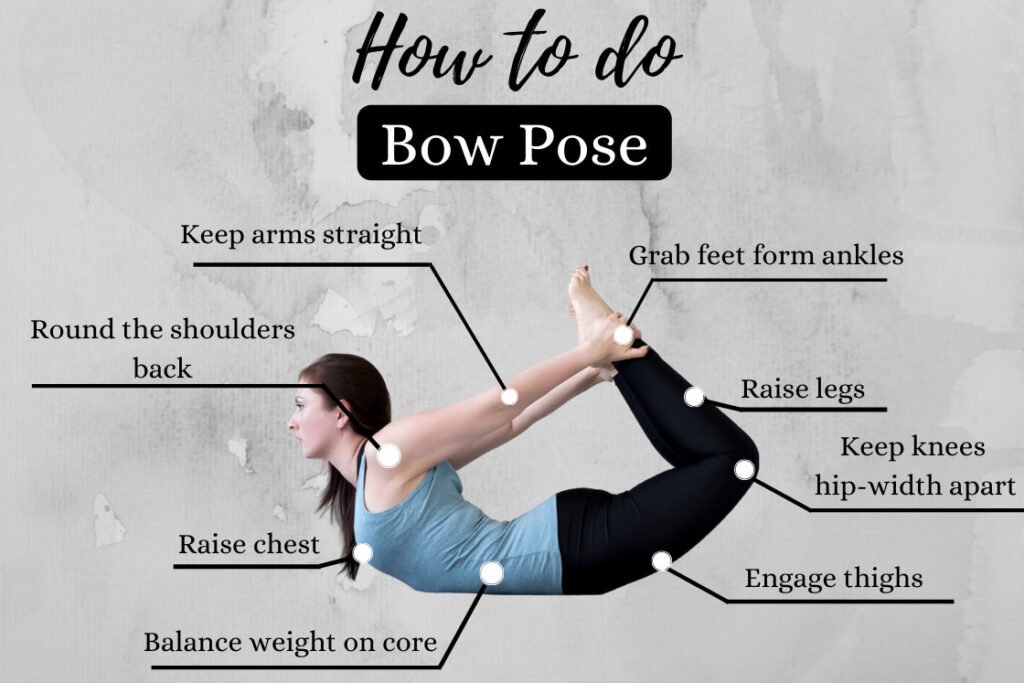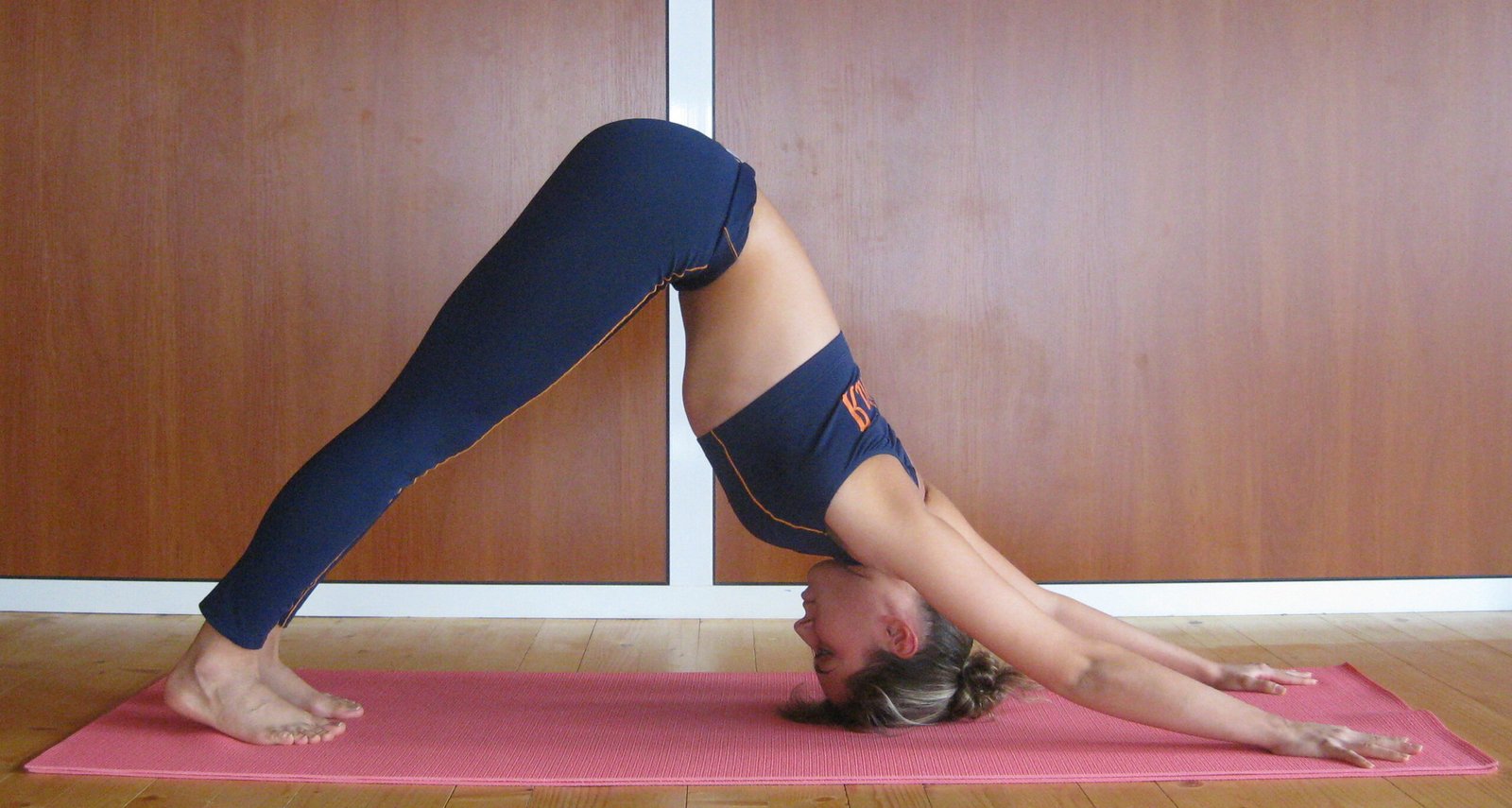Table of Contents

What is Dhanurasana ( Bow pose )
The Dhanurasana in yoga is known as “Bow pose.” It is a backbend pose that resembles the shape of a bow, with the body forming an arch. Dhanurasana is a fantastic yoga posture that offers various physical and mental benefits
How to do Dhanurasana ( Bow pose )

Step 1: Preparation
Here is a step-by-step guide on how to perform Dhanurasana, also known as Bow Pose, in yoga:
- Start by lying flat on your stomach (prone position) on a yoga mat. Keep your legs straight and your arms alongside your body.
Step 2: Bend Your Knees
- Bend your knees and bring your heels as close to your buttocks as possible. Keep your feet hip-width apart.
Step 3: Reach Back
- Reach back with your arms and try to grasp your ankles. If you can’t reach your ankles, you can also hold the sides of your feet. Ensure your grip is firm but not too tight.
Step 4: Inhale and Lift
- Take a deep breath in. As you exhale, start to lift your chest and thighs off the mat by pressing your feet into your hands. Simultaneously, pull your feet back to create tension in your arms.
Step 5: Arch Your Back
- Continue to lift your chest, pulling your shoulders away from your ears, and arching your back as much as your body allows. This action creates a bow-like shape with your body.
Step 6: Hold the Pose
- Hold Dhanurasana for about 15-30 seconds or as long as you are comfortable. As you hold the pose, keep breathing deeply and steadily. Focus on the stretch in your chest, thighs, and abdomen.
Step 7: Release
- To release the pose, exhale gently and lower your chest and thighs back to the mat. Release your ankles or feet and stretch your legs out.
Step 8: Rest
- After releasing the pose, rest in the prone position for a few breaths, turning your head to one side to relax your neck.
Tips:
- Keep your knees about hip-width apart while holding your ankles or feet.
- Maintain a relaxed neck; avoid straining it by looking too far forward or upward.
- If you are a beginner or have any back or neck issues, consider consulting a yoga instructor for guidance and modifications.
- Over time, work on increasing the duration and depth of the pose as your flexibility and strength improve.
Dhanurasana, or Bow Pose, is an excellent yoga asana for strengthening the back, improving posture, and increasing flexibility in the front of the body. It also promotes stress relief and overall vitality. Remember to practice this pose with mindfulness, respecting your body’s limits, and gradually progressing as you become more comfortable with it.
read aboutYoga : 15Benefits of Yoga
Best time to do Dhanurasana (Bow Pose)
The best time to practice Dhanurasana (Bow Pose) can vary from person to person based on individual preferences and needs. However, here are some general recommendations for the best times to do Dhanurasana:
- Morning: Practicing Dhanurasana in the morning can be invigorating and help energize your body and mind for the day ahead. It can be a great way to start your day with a sense of vitality.
- Before a Yoga Session: Dhanurasana can be included as part of your yoga routine, either at the beginning to warm up or in the middle of your sequence to work on backbends and flexibility.
- Evening: Some people prefer to practice Dhanurasana in the evening as a way to unwind, release tension, and prepare for a restful night’s sleep. It can help alleviate the physical and mental stress accumulated throughout the day.
- Before Meditation: Incorporating Dhanurasana into your yoga practice before meditation can help open up the chest and improve posture, making it more comfortable to sit for extended periods during meditation.
- Stress Relief: If you’re using Dhanurasana as a stress-relief practice, you can do it whenever you feel stressed, anxious, or mentally fatigued. It can help you relax and find a sense of calm.
- After Exercise: If you engage in other physical activities like running or strength training, consider doing Dhanurasana as part of your cool-down routine to stretch and release muscle tension.
- As Needed: Ultimately, the best time to practice Dhanurasana depends on your personal schedule and how your body responds. You can do it whenever you have the time and inclination to practice.
Remember that yoga is a flexible practice, and you can adapt it to your daily routine. What’s most important is consistency and listening to your body. If you’re new to Dhanurasana or have specific health concerns, it’s a good idea to consult a qualified yoga instructor for guidance on when and how to incorporate this pose into your practice safely and effectively.
Precautions for Dhanurasana
When practicing Dhanurasana (Bow Pose) or any yoga pose, it’s essential to take certain precautions to ensure your safety and maximize the benefits of the pose. Here are some precautions to keep in mind:
- Consult a Professional: If you are new to yoga or have any medical conditions, especially back issues, neck problems, or recent surgeries, it’s advisable to consult a qualified yoga instructor or a healthcare professional before attempting Dhanurasana or any advanced yoga pose.
- Warm-Up: Always start your yoga practice with a proper warm-up. Gentle stretching and warming up your back, shoulders, and legs can help prepare your body for the demands of Dhanurasana.
- Avoid Overexertion: Do not force your body into the pose. Listen to your body’s signals, and go only as far as is comfortable. Overexertion can lead to injury.
- Be Mindful of Alignment: Proper alignment is crucial in Dhanurasana. Ensure that your knees are about hip-width apart, and try to maintain symmetry in the arch of your back. Misalignment can strain your muscles and spine.
- Neck Safety: Keep your neck relaxed and avoid craning it backward. Instead, gaze forward or slightly upward to maintain a neutral neck position.
- Breathing: Focus on deep and even breathing while in the pose. Avoid holding your breath. The breath can help you maintain balance and relaxation in the pose.
- Gradual Progression: If you are a beginner, start with milder backbends and gradually work your way up to Dhanurasana. Building strength and flexibility over time is key to mastering this pose.
- Use Props: If you have difficulty reaching your ankles or holding the pose comfortably, you can use yoga props like a strap or a yoga block to aid in the posture.
- Modify as Needed: Don’t hesitate to modify the pose to suit your current ability. You can start by bending your knees less or lifting your chest lower off the ground if needed.
- Injury Awareness: If you experience pain or discomfort, particularly in the lower back or neck, while practicing Dhanurasana, release the pose immediately and consult a professional if necessary.
- Pregnancy: Pregnant individuals should avoid deep backbends like Dhanurasana, especially during the later stages of pregnancy. Consult with a prenatal yoga instructor for suitable alternatives.
- Consistency: Regular practice can help improve your ability to perform Dhanurasana safely. Be patient and consistent in your practice to reap the full benefits.
Always remember that yoga is a personal journey, and your progress may differ from others. Prioritize safety and mindfulness in your practice, and consider seeking guidance from an experienced yoga instructor to ensure that you perform Dhanurasana correctly and safely.
Top 20 Benefits of Dhanurasana ( Bow pose )
Dhanurasana, or Bow Pose, is a yoga asana that offers a wide range of benefits for the body and mind. Here are the top 20 benefits of Dhanurasana:
- Strengthens the Back: Dhanurasana is excellent for strengthening the muscles along the spine, promoting a healthy and robust back.
- Improved Posture: Regular practice can help correct poor posture by engaging the upper back muscles and encouraging an open chest.
- Enhanced Spinal Flexibility: The pose stretches and flexes the entire spine, improving its flexibility and range of motion.
- Stimulated Digestive Organs: The compression of the abdomen during the pose stimulates the digestive organs, aiding digestion.
- Increased Flexibility: Dhanurasana stretches the front of the body, including the abdomen, hip flexors, thighs, and chest, enhancing overall flexibility.
- Stronger Limbs: It engages the muscles in the arms and legs, contributing to overall physical strength.
- Boosts Energy Levels: The dynamic nature of the pose can invigorate the body, reducing fatigue, and increasing energy levels.
- Reduces Stress: The heart-opening aspect of the pose can alleviate stress, anxiety, and emotional fatigue.
- Enhanced Respiratory Health: Dhanurasana encourages deep, diaphragmatic breathing, improving lung capacity and respiratory health.
- Aids in Weight Management: When combined with a balanced diet and lifestyle, it can support weight management efforts by stimulating the metabolism.
- Improved Concentration: Balancing in Dhanurasana requires concentration and mindfulness, helping to enhance mental focus.
- Better Balance and Coordination: The pose challenges balance and coordination, improving overall body awareness.
- Toned Abdominal Muscles: The engagement of the core muscles can help tone and strengthen the abdominal region.
- Alleviates Menstrual Discomfort: Dhanurasana can provide relief from menstrual discomfort and cramps when practiced regularly.
- Enhanced Kidney Function: The compression of the abdomen can stimulate the kidneys and improve their function.
- Better Digestion: It can help relieve constipation and other digestive issues by massaging the digestive organs.
- Pain Relief: Dhanurasana may alleviate mild back pain and sciatica by strengthening the back muscles.
- Balanced Nervous System: The pose can help balance the sympathetic and parasympathetic nervous systems, promoting relaxation.
- Detoxification: It aids in detoxifying the body by stimulating the lymphatic system and encouraging the removal of toxins.
- Emotional Release: Dhanurasana can release pent-up emotions, providing a sense of emotional release and catharsis.
It’s important to note that while Dhanurasana offers many benefits, it should be practiced mindfully and with proper alignment. Beginners or those with specific health concerns should seek guidance from a qualified yoga instructor to perform the pose safely and effectively.
Dhanurasana (Bow Pose) contraindications
Dhanurasana (Bow Pose) is a challenging yoga pose that offers numerous benefits, but it may not be suitable for everyone. It’s essential to be aware of the contraindications and precautions associated with this pose to avoid potential injuries or discomfort. Here are some contraindications for Dhanurasana:
- Recent Surgery: If you have had recent abdominal or back surgery, it’s best to avoid Dhanurasana until you have fully healed and received clearance from your healthcare provider.
- Herniated Disc: Individuals with a herniated disc or severe disc issues in the spine should avoid deep backbends like Dhanurasana, as it can aggravate the condition.
- Chronic Back Pain: If you have chronic back pain or any ongoing back issues, consult with a healthcare professional or experienced yoga instructor before attempting Dhanurasana. Modifications or alternative poses may be necessary.
- Neck Problems: People with severe neck issues, such as cervical herniation or instability, should avoid lifting their heads too high during Dhanurasana. Keeping the head in a neutral position is essential to prevent further strain.
- High Blood Pressure: Individuals with uncontrolled high blood pressure should exercise caution when practicing Dhanurasana, as it can temporarily increase blood pressure. Consult a healthcare provider and consider avoiding or modifying the pose.
- Heart Conditions: Those with heart conditions or heart-related surgeries should be cautious when performing backbends, as they can affect blood flow and heart rate. Consult with a healthcare professional before attempting advanced poses like Dhanurasana.
- Pregnancy: Pregnant individuals, especially those in the later stages of pregnancy, should avoid deep backbends like Dhanurasana, as it can put excessive pressure on the abdomen and potentially harm the baby. Prenatal yoga poses are more suitable during pregnancy.
- Recent Abdominal Surgery: If you’ve had recent abdominal surgery, Dhanurasana may not be appropriate due to the abdominal compression involved in the pose. Always consult with your surgeon or healthcare provider for guidance.
- Glaucoma: People with glaucoma should be cautious when practicing inverted or intense backbend poses like Dhanurasana, as these can increase intraocular pressure. Consult an eye specialist for guidance.
- Osteoporosis: Individuals with osteoporosis or low bone density should avoid deep backbends that put pressure on the spine, as this can increase the risk of fractures.
- Wrist or Ankle Injuries: If you have injuries or conditions affecting your wrists or ankles, you may find it uncomfortable to grasp your ankles in Dhanurasana. Modifications or props may be needed.
- Inflammatory Conditions: People with acute inflammatory conditions, such as rheumatoid arthritis, should exercise caution when practicing Dhanurasana, as it may exacerbate inflammation.
It’s essential to practice yoga mindfully, especially when attempting advanced poses like Dhanurasana. If you have any doubts about whether this pose is safe for you, or if you have specific health concerns or conditions, consult with a qualified yoga instructor or healthcare provider before including it in your practice. They can provide guidance on modifications or alternative poses that are more suitable for your individual needs and abilities
Health and skin Beneits of Dhanurasana
Dhanurasana (Bow Pose) offers a range of health and skin benefits when practiced regularly. Here are some of the notable advantages for both your overall health and skin health:
Health Benefits:
- Improved Posture: Dhanurasana helps correct poor posture by opening up the chest, strengthening the upper back muscles, and promoting an upright alignment of the spine.
- Stronger Back: This pose strengthens the muscles along the spine, making it beneficial for individuals with mild back pain and discomfort.
- Enhanced Flexibility: Dhanurasana stretches the entire front of the body, including the abdomen, hip flexors, and thighs, improving overall flexibility.
- Stimulated Digestive Organs: The compression of the abdomen in this pose stimulates the digestive organs, potentially aiding digestion and reducing digestive discomfort.
- Toned Abdominal Muscles: Engaging the core muscles in Dhanurasana can help tone and strengthen the abdominal region.
- Improved Respiratory Health: The deep, diaphragmatic breathing encouraged in this pose enhances lung capacity and overall respiratory health.
- Stress Reduction: Dhanurasana’s heart-opening nature can help alleviate stress and anxiety, promoting a sense of relaxation.
- Increased Energy Levels: The dynamic arching position of this pose can invigorate the body, reducing feelings of fatigue and boosting energy.
- Enhanced Concentration: Balancing in Dhanurasana requires concentration and mindfulness, which can improve mental focus and clarity.
Skin Benefits:
- Increased Blood Circulation: The arching position of Dhanurasana enhances blood circulation, delivering oxygen and nutrients to the skin cells, which can contribute to a healthier complexion.
- Stress Reduction: Reduced stress, which can result from regular practice of Dhanurasana, can have a positive impact on the skin. Stress is often associated with skin issues like acne and dullness.
- Detoxification: Dhanurasana aids in detoxifying the body by stimulating the lymphatic system, which helps remove toxins from the body. This detoxification process can lead to clearer skin.
- Improved Digestion: Better digestion, supported by the compression of the abdominal organs in Dhanurasana, can indirectly benefit the skin by promoting overall health.
- Balanced Hormones: Stress reduction and improved hormonal balance through regular yoga practice can help prevent hormone-related skin issues like acne.
- Radiant Complexion: The combination of increased blood circulation, reduced stress, and improved digestion can contribute to a healthier, more radiant complexion.
- Slows Signs of Aging: Regular practice of Dhanurasana can help maintain skin elasticity and reduce the appearance of fine lines and wrinkles.
It’s important to note that while Dhanurasana offers these potential health and skin benefits, individual results may vary. To maximize these advantages, practice Dhanurasana as part of a well-rounded yoga routine, maintain a healthy diet, stay hydrated, and follow a proper skincare regimen. Additionally, if you have specific skin concerns or conditions, consult a dermatologist for personalized guidance and treatment options.
Conclusion
In conclusion, Dhanurasana, also known as Bow Pose in yoga, is a dynamic and invigorating posture that offers a multitude of health and skin benefits. When practiced regularly, it can contribute to improved posture, back strength, and flexibility. It stimulates the digestive organs, enhances respiratory health, and reduces stress, promoting overall well-being. For the skin, Dhanurasana can lead to a healthier complexion by increasing blood circulation, reducing stress-related skin issues, detoxifying the body, and promoting a radiant appearance.
However, it’s essential to practice Dhanurasana mindfully, with proper alignment, and to be aware of any contraindications or precautions, especially if you have specific health concerns or conditions. Consulting a qualified yoga instructor or healthcare provider is advisable for personalized guidance.
Incorporating Dhanurasana into your yoga practice can be a transformative experience, offering both physical vitality and emotional balance. To enjoy these benefits fully, make Dhanurasana a part of your holistic wellness routine, alongside a balanced diet, hydration, and proper skincare.
FAQs
Here are some frequently asked questions (FAQs) about Dhanurasana (Bow Pose) in yoga:
1. What is Dhanurasana, and how is it performed?
- Dhanurasana, or Bow Pose, is a yoga pose that involves lying on your stomach, bending your knees, and reaching back to hold your ankles. You then lift your chest and thighs off the ground to create a bow-like shape with your body.
2. What are the benefits of practicing Dhanurasana?
- Dhanurasana offers numerous benefits, including improved back strength, posture, and flexibility. It stimulates digestion, enhances respiratory health, reduces stress, and can promote radiant skin.
3. Are there any contraindications for Dhanurasana?
- Yes, Dhanurasana may not be suitable for individuals with certain medical conditions, such as severe back issues, herniated discs, high blood pressure, recent abdominal surgery, and more. It’s essential to practice with caution and consult a healthcare provider if you have concerns.
4. Can beginners practice Dhanurasana?
- While Dhanurasana can be challenging, beginners can work on building the necessary strength and flexibility over time. Starting with modified versions and seeking guidance from a yoga instructor is advisable.
5. How long should I hold Dhanurasana?
- The duration of holding Dhanurasana can vary from person to person. Typically, you can aim to hold it for 15-30 seconds initially and gradually increase the duration as you become more comfortable with the pose.
6. Can Dhanurasana help with back pain?
- Dhanurasana can be beneficial for individuals with mild back discomfort as it strengthens the muscles along the spine. However, those with severe back issues should practice under supervision and with caution.
7. Is it safe to practice Dhanurasana during pregnancy?
- Pregnant individuals should avoid deep backbends like Dhanurasana, especially in the later stages of pregnancy. Prenatal yoga poses are more suitable during this time.
8. How can I improve my flexibility for Dhanurasana?
- Consistent practice of yoga poses that target the chest, shoulders, hip flexors, and thighs can help improve flexibility, making Dhanurasana more accessible over time.
9. What should I do if I can’t reach my ankles in Dhanurasana?
- If you cannot reach your ankles comfortably, you can use a strap or a yoga block to assist in the pose. Gradually work on increasing your flexibility to reach your ankles with practice.
10. Is it necessary to warm up before attempting Dhanurasana? – Yes, warming up is essential before attempting Dhanurasana to prepare your body for the pose. Gentle stretches and warm-up exercises for the back, shoulders, and legs are recommended.
These FAQs provide valuable information about Dhanurasana, but it’s crucial to remember that individual experiences and abilities may vary. Consult with a qualified yoga instructor or healthcare provider for personalized guidance and modifications based on your unique circumstances.
https://en.wikipedia.org/wiki/Dhanurasana
also read about Acupressure Points : How acupressure works | All in 1






